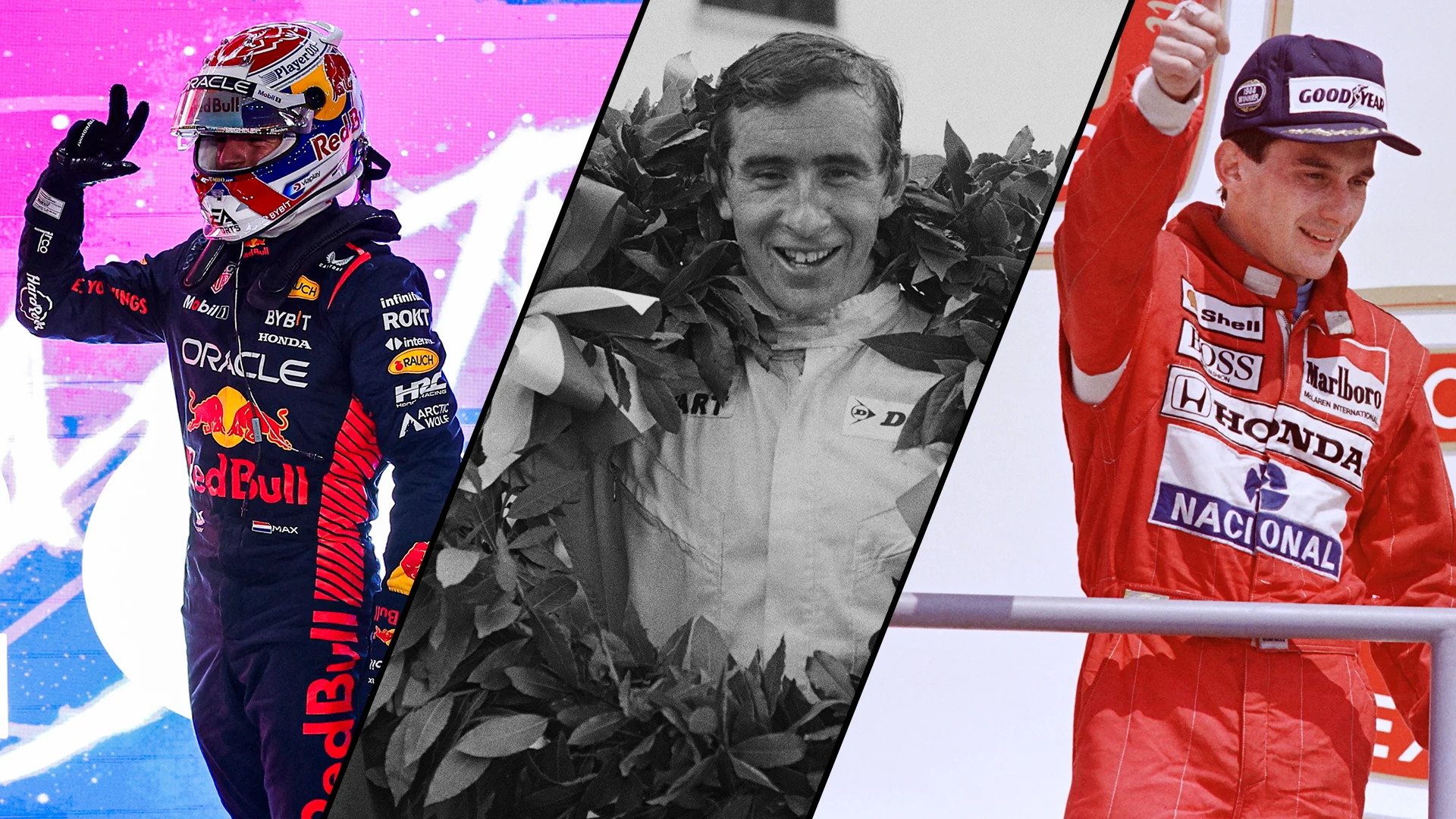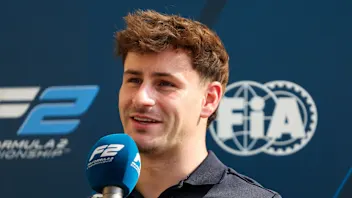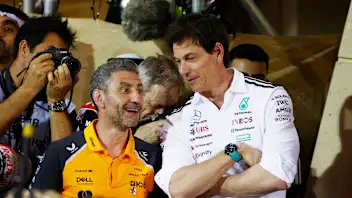Verstappen’s fellow three-time champions – and the greats he’s overtaken in the all-time list


Max Verstappen joined an elite club of triple world champions with his latest triumph over the Qatar Grand Prix weekend. With the dust settling on the achievement, we take a trip through the archive to shine a light on F1’s other three-time title winners, along with the legendary names the Dutchman has now cleared in the all-time list.
Three-time F1 world champions
Jack Brabham
Following on from Juan Manuel Fangio, who brilliantly racked up five world titles across the 1950s, Jack Brabham was the next F1 driver to reach the heights of three championships.
Brabham achieved his initial brace with Cooper, making the most of the British team’s pioneering move to rear-engined machinery. In 1959, he became the first Australian to win an F1 race and then the drivers’ crown via a dramatic finale at Sebring, pushing his fuel-less car to the line, before doing the double the following year with a mid-season run of five successive victories.
Brabham went on to form an eponymous squad as the 1960s developed and eventually secured a third and final crown in 1966 (and so nearly another in 1967), making him the first – and to this day only – driver to win the F1 championship in a car bearing their own name.
Jackie Stewart
Jackie Stewart had enjoyed some early success with BRM in the mid-1960s, but his career stepped up a gear when he moved to Tyrrell’s Matra International team.
Having run Lotus rival Graham Hill close for the 1968 championship, Stewart’s breakthrough season came in 1969 with a dominant display that included six wins from 11 races and contributed to a then-whopping title-winning advantage of 26 points over Brabham’s Jacky Ickx.
After a retirement-filled 1970 campaign, Stewart and Tyrrell returned to form and, over the next three seasons, the ‘Flying Scot’ added the 1971 and 1973 championship trophies to his cabinet. Later turning his hand to broadcasting and running his own F1 team, he remained the only British driver to win three titles until Lewis Hamilton – who now holds seven – in 2015.
Niki Lauda
Niki Lauda arrived on the F1 scene in the early 1970s and, after catching the eye of Ferrari chiefs with some plucky backmarker performances, he wrote the first chapter of his success in red.
Having stormed to the 1975 title, Lauda was pushing to make it two in a row when he suffered a fiery accident at the Nurburgring, prompting a priest to read him the last rites in hospital. He heroically returned to action just six weeks later and was only narrowly beaten to the 1976 title by McLaren’s James Hunt after pulling out of the finale in Fuji amid torrential rain.
READ MORE: Wolff admits to missing Niki Lauda during difficult times for Mercedes
Lauda hit back in 1977 to secure a second championship, but souring relations at Ferrari saw him head to Brabham where, after a couple of seasons with limited success, he retired from the sport to pursue other interests, which included establishing his own airline.
A few years later, Ron Dennis and McLaren tempted him back, with a third title win coming in 1984 when he pipped up-and-coming team mate Alain Prost by half a point.
Nelson Piquet
As it transpired, Lauda left Brabham just before the now Bernie Ecclestone-run operation became a championship-winning force again, with Nelson Piquet going on to reap the rewards.
Having finished runner-up in 1980, Piquet got his hands on the drivers’ trophy for the first time at the end of the 1981 season, moving one point clear of Williams rival Carlos Reutemann with a fifth-place finish in the Las Vegas showdown. He followed it up in 1983, beating then Renault racer Prost by a similarly tight margin.
READ MORE: Prost vs Senna, Mansell vs Piquet and more – F1’s fiercest team mate rivalries
With just three more race wins coming over the next two seasons, and another title challenge looking unlikely, Piquet made the switch to Williams, where he and team mate Nigel Mansell would strike up a fierce rivalry.
In the 1986 finale at Adelaide, a spectacular tyre blowout for Mansell and a precautionary pit stop for Piquet derailed their efforts, opening the door for Prost – now at McLaren. In 1987, and amid major tensions at Williams, it was Piquet who emerged victorious after a heavy qualifying crash at Suzuka forced Mansell out of the last two races.
Ayrton Senna
Ayrton Senna had been a contender for the 1986 and 1987 titles while shining with Lotus, but his move to McLaren alongside Prost gave him a first genuine shot at championship glory.
In 1988, Senna, Prost and the McLaren MP4/4 were in a league of their own – the duo winning all bar one of the 16 races held. It was the Brazilian youngster who came out on top with eight victories to Prost’s seven, ending the season three points ahead.
However, all was not well between the McLaren drivers and a series of flashpoints would define their time together, the most talked about being that 1989 collision at Suzuka. While Prost was out of the penultimate round on the spot, Senna returned to the track and took victory, only to be disqualified for rejoining illegally, handing his team mate the crown.
With no hope of a reconciliation, Prost decamped to Ferrari for 1990 and Senna sealed that year’s title after another controversial clash between the arch-rivals in Japan. Senna added a third and final championship to his name in 1991, moving to Williams a couple of seasons later and tragically passing away following a crash at the 1994 San Marino Grand Prix.
Two-time F1 world champions
Alberto Ascari
After Giuseppe ‘Nino’ Farina won the inaugural F1 championship in 1950 and Fangio took the first of his aforementioned five crowns in 1951, Alberto Ascari secured the honour of becoming the sport’s maiden double title winner – and, to this day, the last Italian to lift the drivers’ trophy.
Racing for Ferrari, Ascari romped his way to the 1952 title by winning six of the seven championship races he contested, before taking five more victories the following season to make it two from two. However, his hopes of adding to that tally of F1 titles, and similar success in sportscars, would soon be cruelly ended.
READ MORE: From Ascari to Verstappen – How all 11 back-to-back F1 champions did the double
Having made the move to Lancia, Ascari was given special dispensation to contest the 1000 Kilometres of Monza in a Ferrari alongside his friend, Eugenio Castellotti, only to sustain fatal injuries while giving their car a test run at the Temple of Speed.
Jim Clark
As per Ascari and many other drivers racing from bygone eras, Jim Clark combined several motorsport categories with F1, where he and Lotus formed a potent combination across the 1960s.
There is a case for arguing that Clark should have won five titles between 1962 and 1967, were it not for a host of reliability problems. Nonetheless, the Scot got two on the board in 1963 and 1965 respectively, winning 13 of the 19 races he took part in across those two seasons – skipping Monaco during the latter year to take on and win the prestigious Indianapolis 500.
READ MORE: 6 times the best F1 drivers and best cars combined to produce relentless brilliance
Clark’s journey was another that met a tragic end, the superstar talent losing his life aged just 32 in a Formula 2 accident at Hockenheim after winning the first round of the 1968 F1 season.
Graham Hill
After debuting in F1, Hill had to wait five years for his first championship win, but once that came he established himself as a front-running force for the best part of a decade.
Indeed, four wins for the then BRM racer across the 1962 season netted him title number one and he followed that up with runner-up spots in 1963, 1964 (missing out by just one point) and 1965. Hill later joined Clark at Lotus and, following his team mate’s death, claimed a third and final crown in 1968.
MR MONACO: How Graham Hill mastered the streets of Monte Carlo
Hill also sadly lost his life while still competing, but rather than an accident on the track, the Briton was killed – along with members of the eponymous team he had formed – in a plane crash when flying back to the UK from a test session in France.
Emerson Fittipaldi
Emerson Fittipaldi also wrote a chapter of F1 success with Lotus, emerging as the team’s lead driver following another tragedy that befell Jochen Rindt – the posthumous 1970 world champion who was killed in a practice incident at the Italian Grand Prix.
Having scored his first win at the end of the 1970 season and taken several more podiums in 1971, it was 1972 that proved to be Fittipaldi’s breakthrough year as he became the sport’s first title winner from Brazil and the youngest up to that point, aged only 25.
Fittipaldi remained a contender in the three seasons that followed, finishing as the 1973 runner-up before moving over to McLaren and becoming the British team’s first F1 champion in 1974, which he backed up with a second-place classification next time around.
After parting ways with McLaren, Fittipaldi went on to race for the eponymous team he set up with his brother, Wilson, but never to the same level of success he had enjoyed previously.
Mika Hakkinen
With his initial schooling at Lotus behind him and having recovered from a shocking qualifying crash at Adelaide in 1995, Mika Hakkinen was in prime position to capitalise when McLaren hit form with their Mercedes-powered, Adrian Newey-designed machines in the late-1990s.
Fresh from a maiden race win at the 1997 finale, Hakkinen won four of the opening six rounds in 1998 to make his intentions clear, fending off a challenge from Michael Schumacher and Ferrari to land the title. He followed it up with another crown in 1999, this time keeping the other Ferrari of Eddie Irvine at bay after Schumacher’s leg-breaking crash at Silverstone.
Hakkinen was firmly in the hunt to make it three on the bounce in 2000, only for Schumacher to edge the battle during a stunning late-season run, with the Finn then calling time on his career at the end of the 2001 campaign. He flirted with the idea of a comeback in later years, but ultimately remained on the sidelines and settled for his two championship crowns.
Fernando Alonso
Fernando Alonso, still racing in F1 to this day, is the final driver to feature on our two-time champions’ list, having written his name in the history books with Renault almost 20 years ago.
After taking his first pole position and race win in 2003, and adding several more trophies to his cabinet the following year, a sustained spell in the sun – and ultimately two world titles – followed for Alonso during the mid-noughties.
READ MORE: From Hungary 2003 to Spain 2013 – Ranking Alonso's best wins from 10 to 1
In 2005, which brought major aerodynamic changes amongst other rule tweaks, Alonso and Renault saw off Kimi Raikkonen and McLaren to clinch a maiden title, before the Spaniard overcame the recovering Schumacher/Ferrari partnership – whose lengthy run he had ended – across a pulsating 2006 season.
A series of team changes and missed opportunities followed for Alonso, who came agonisingly close to further championships with McLaren in 2007 and Ferrari in 2010 and 2012, meaning his hunt for a coveted third crown goes on.




.webp)
